ISSN 2410-5708 / e-ISSN 2313-7215
Year 9 | No. 26 | p. 147 - 284 | October 2020 - January 2021
© Copyright (2020). National Autonomous University of Nicaragua, Managua.
This document is under a Creative Commons
Attribution-NonCommercial-NoDerivs 4.0 International licence.
Collaborative learning as a didactic strategy to promote oral English practice in extra-school hours using Google Hangouts
https://doi.org/10.5377/torreon.v9i26.10255
Submitted on April 2, 2020 / Accepted on July 8, 2020
MSc. Ronier Eliézer Peña López
Professor Researcher
UNAN-Managua, FAREM-Chontales
Section: Education
SCIENTIFIC ARTICLES
Keywords: collaborative learning, Google Hangouts, English oral practice, extra school hours.
ABSTRACT
The present study aims to analyze the incidence of collaborative learning to promote oral English practice in extra-curricular hours among students in the third year of the English career during the second semester of 2017: Google Hangouts as a technological application. This study is positioned in the socio-critical paradigm, with a mixed approach, which is descriptive and cross-sectional. The sample was of 38 informants, 4 teachers, and 34 students. The survey and the interview were used as information collection instruments validated through a pilot and expert judgment, respectively. The data were analyzed using SPSS version 21 software in the quantitative phase, and in the qualitative phase, using matrices of main categories, then a triangulation of the information obtained was carried out.
As main results, we found that most of the students are familiar with the use of Google Hangouts, and motivated to practice English through this tool, as well as through participation in collaborative learning activities, which contributed to improving other English sub-skills that foster the development of oral competence. On the other hand, teachers do apply activities oriented to the practice of English through ICT resources, but these are not directly focused on the development of oral language practice.
In conclusion, the study showed that it had a positive impact both on the motivational aspect of the students, as well as on their competencies and communication skills in the English language.
1. INTRODUCTION
UNAN Managua, through the Facultad Regional Multidisciplinaria de Chontales (FAREM-Chontales), offers a Bachelor of Education Science with a minor in English, which aims to train teachers in the teaching of English as a foreign language, who will work at different levels of education in the country and also could be actively involved in a professional and bilingual environment, with the ability to develop professionally in any region of English-speaking countries. (UNAN Managua, 2012).
The study on Collaborative Learning as a didactic strategy to promote the oral practice of English in extra-school hours using Google Hangouts, was born from the need to practice and develop the oral competence of English, such need is experienced by students, who first of all are eager to speak the language, however, when doing so, they feel intimidated, under the pressure of time or their peers, or because of the complexity of the activities presented by the teachers, they tend to use their mother tongue more frequently in language interaction activities, or, conversely, some students speak a lot while others remain silent, making the students’ speaking time uneven and preventing all students from practicing oral skills in the classroom.
It is important to note that communicative competence is defined in the Framework of Reference for Languages as the set of “competences which enable a person to act specifically through linguistic means” (Instituto Cervantes, 2002, p. 9). In other words, this competence enables the person to use the knowledge of the language and relate it to the knowledge he or she has of the world to communicate and interact with others in any context.
For this reason, when talking about teaching, mediated strategies should be highlighted both inside and outside the classroom where there is an endless range of options to take advantage of. It is worth mentioning collaborative learning as a learning strategy. Scagnoli (2005) points out that “collaborative learning is immersed in the theory of social constructivism and is based on the process of building knowledge through learning from interaction with a group and through tasks carried out in cooperation with others”. (p.2)
Based on the above, collaborative learning is then defined as a key element in language learning, since it promotes positive relationships between students, and in turn provides a healthy social, psychological and cognitive development experience, and replaces competence with collaboration, as well as raising the achievement of all students.
It is important to emphasize that this strategy can be developed through appropriate activities related to the use of ICT resources, which focused on the teaching of English is a mediating resource for learning and a motivation to practice and use the language in real situations, as well as helping to improve language skills (listening, speaking, writing and reading) interactively and collaboratively (Chacón and Pérez, 2011. p. 42).
Regarding previous studies related to the use of technological applications and English learning, only the work of Saavedra (2016) was found in the national scope, in which it is studied in what way the use of the social network Facebook as a mediating didactic tool, favors the development of the basic abilities of the English language
On the other hand, at an international level, the work of Salas-Alvarado, J. (2016) was found, the author tackles collaborative learning for English learning by applying interactively and dynamically different activities that allowed the creation of a very interesting collaborative work link between students, which allowed the development of oral competence.
Following the experience of this background, it was established that this work aims to collect information on the accessibility of ICT resources in students, and verify the effectiveness of the use of collaborative learning as a teaching strategy using Google hangouts to benefit both students and teachers in the process of teaching-learning English. For teachers, such information can be useful to appropriate new experiences for the promotion and monitoring of oral practice in out-of-school hours, which facilitate the strengthening of the processes of acquisition of the new language and ensure the achievement of oral competence at the end of the learning. On the other hand, students will be motivated to use the language more frequently outside the classroom through the use of technological resources which will give them the opportunity to enter into a more innovative, dynamic and effective learning process.
2. METHODOLOGY
Based on Hernández, Fernández, & Baptista (2006) the study was carried out under the mixed approach, of a descriptive nature, because it systematically characterizes and interprets the perceptions of teachers and students on the impact of the collaborative learning strategy to promote the practice of English.
This study was carried out at UNAN Managua, FAREM Chontales, in the second half of 2017. The sample that was selected for this study was 34 students from the third year of the Bachelor of Education Science with a minor in English at UNAN-Managua, FAREM Chontales as well as 4 teachers from the English area of that faculty.
Data for this study was collected using the following data collection instruments: a diagnostic survey applied to 34 English learners, items were based on two important variables for making the initial diagnosis: internet accessibility and knowledge in terms of the use of technological tools for the English language practice.
The questionnaire was the second instrument applied to the students based on a convenience sampling, this instrument was applied after the implementation of a didactic sequence. And finally the interview with the teachers of the English career of FAREM Chontales.
For the quantitative analysis plan, the data were processed and tabulated using the statistical program SPSS version 21, likewise, the qualitative phase was carried out using matrices of main categories, where a content analysis was made with which the opinion of each informant (teachers) was faithfully specified using the grouping of questions by each category, later coincidences were compared and the analyses were detailed. For the discussion of these, the triangulation of data information based on the second level proposed by McKernan (Leal, 2015) was used.
3. ANALYSIS AND DISCUSSION
The most relevant aspects obtained in the processing of the different instruments used are detailed below.
3.1. Diagnostic student survey
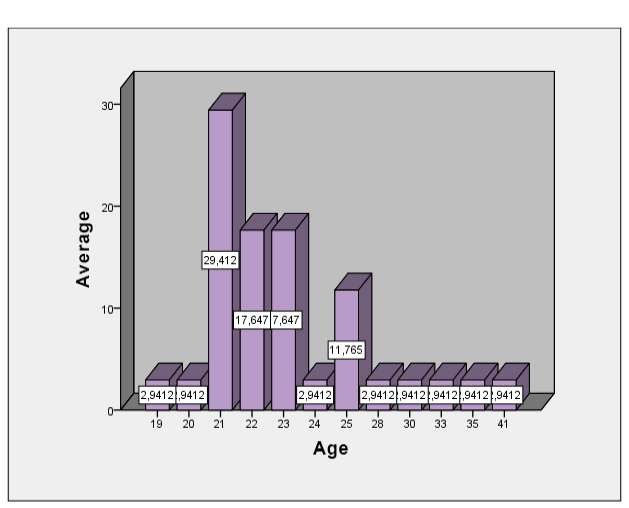
Graph 1. Age of the students
Regarding the age of the respondents, on an average of 29.4%, the predominant age is relatively young with 21 years, where the minimum is 19 and the maximum is 41. Therefore, the acceptance by young people towards the use of ICT is higher.
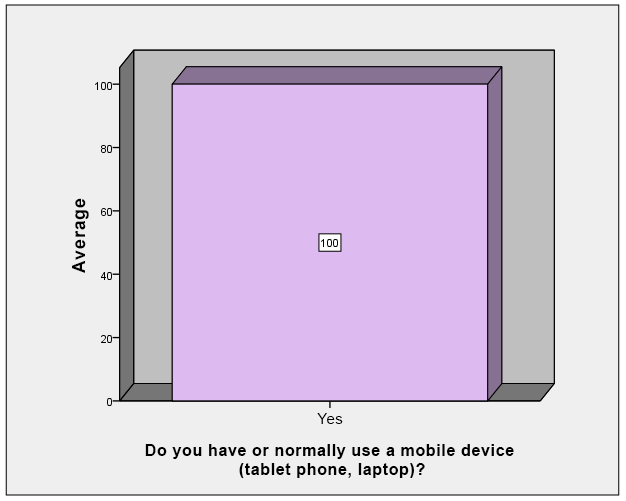
Graph 2. Use of technological device (cell phone, tablet or laptop)
100% of the students use a technological device that reflects a high familiarity with ICT.
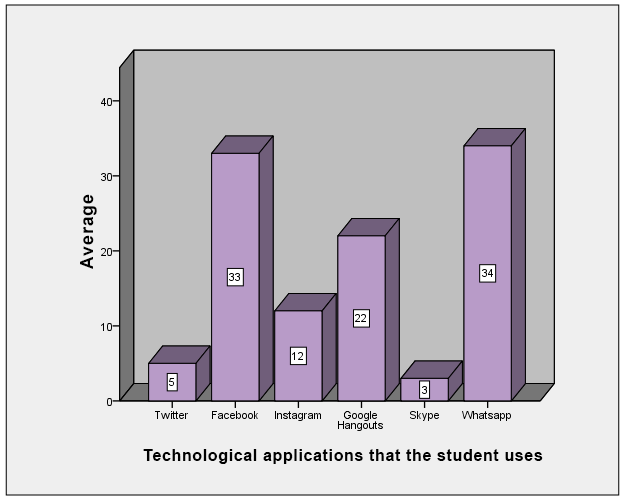
Graph 3. Technological applications that the student uses
The three technological applications most used by students which are: WhatsApp in the first place, followed by Facebook and Google Hangouts, the latter proposal in this thesis as the technological resource to use shows that students are familiar with this application.
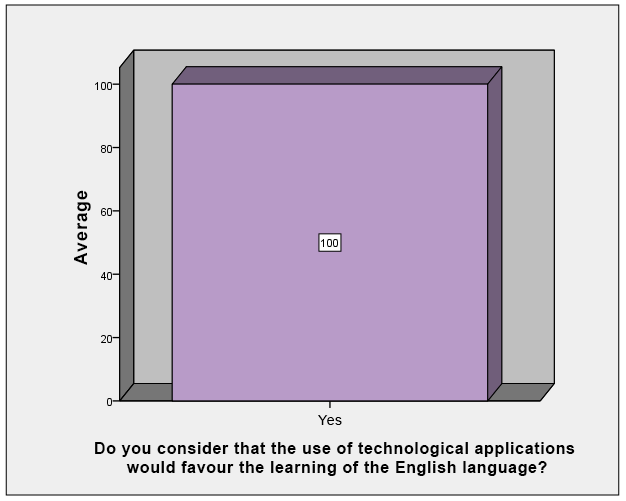
Graph 4. Technological applications and English language learning
100% of the respondents are aware that the use of technological applications can promote language learning. This shows that there is an interest in students towards learning English more dynamically and interactively using ICT.
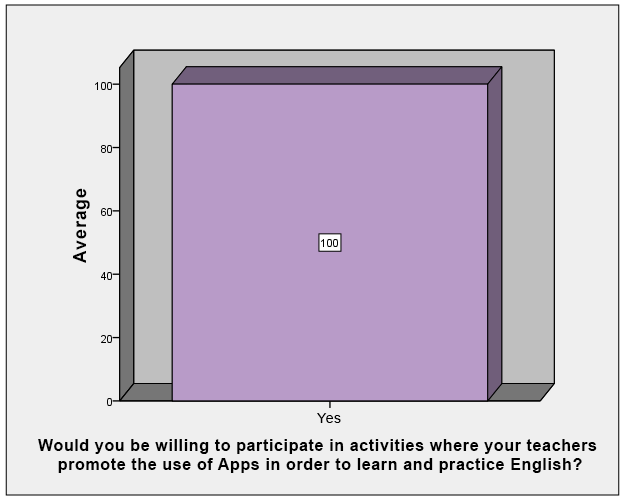
Graph 5. Willingness to participate in activities using Apps to learn and practice English
100% of the students express interest in participating in learning activities and practice English through the use of apps.
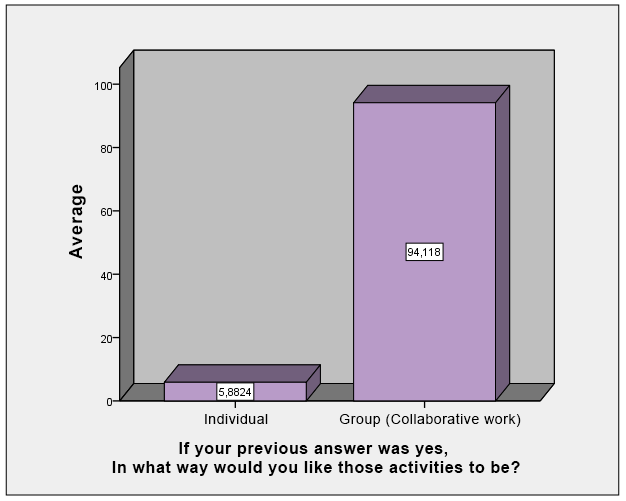
Graph 6. Form of participation in activities
Most of the respondents, that is, 94.1% show inclination towards the participation of activities that involve collaborative learning, while 5.8% would prefer to do them individually.
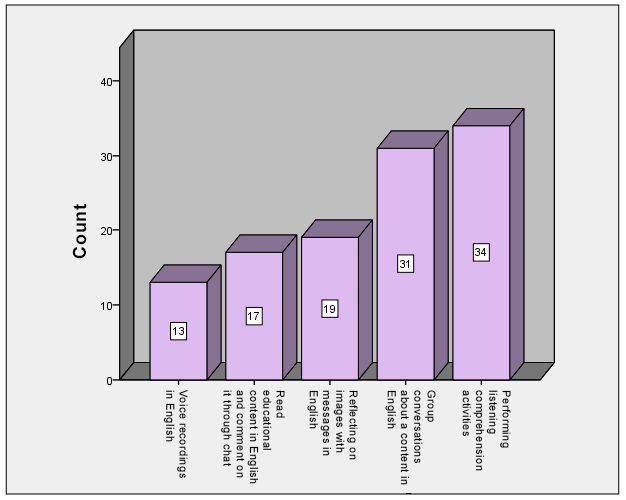
Graph 7. Activities using a technological application to practice English
According to the frequencies presented in the graph, 34 students answered that they are interested in doing listening comprehension activities, followed by 31 responses representing students who want to conduct a conversation in English about some topic using a technological application.
3.2. The questionnaire applied to students after the didactic sequence.
Table 1. Did you like practicing the English language orally using the Google Hangouts application?
|
Frequecy |
Average |
||
|
Valids |
Yes |
21 |
100.0 |
According to table, 100% of the respondents reported feeling comfortable practicing English orally through the Google Hangouts application. One of the most evident reasons was that as it was a new and different activity, it had a positive impact on the activities.
Table 2. Do you feel motivated to continue using this technological application to develop oral English proficiency?
|
Frequecy |
Average |
||
|
Valids |
Yes |
20 |
95.2 |
|
No |
1 |
4.8 |
|
|
Total |
21 |
100.0 |
|
According to the information generated in table, it is observed that 95.2% of the students feel motivated to continue using Google Hangouts to practice and thus improve their oral English competence, while 4.2% of the sample states that they will not continue using it.
Table 3. Was there prior preparation on your part before carrying out the scheduled activities?
|
Frequecy |
Average |
||
|
Valids |
Yes |
20 |
95.2 |
|
No |
1 |
4.8 |
|
|
Total |
21 |
100.0 |
|
It is observed that 95.2% of the sample considers that their degree of responsibility was high since they expressed in the comments that they had to look for information related to the topic to be addressed, practice individually, prepare writings and other types of strategies that would allow them to have a good development in the proposed activities, however, 4.8% considered that their degree of preparation was low due to the available time they had.
Table 4. Did you have feedback from your classmates and teacher at the end of each session?
|
Frequecy |
Average |
||
|
Valids |
Yes |
19 |
90.5 |
|
No |
2 |
9.5 |
|
|
Total |
21 |
100.0 |
|
The 90.5%, representing the majority of the students had positive feedback from their peers and the teacher since it is observed in the comments that the students recognize that the teacher is not always the one who has the knowledge and sees their classmates as a support in their learning process. On the other hand, 9.5% expressed that they did not feel comfortable with the comments they received because they were framed in unconstructive criticism.
Table 5. Did you feel comfortable expressing yourself in English in front of your classmates using the Google Hangouts application?
|
Frequecy |
Average |
||
|
Valids |
Yes |
20 |
95.2 |
|
No |
1 |
4.8 |
|
|
Total |
21 |
100.0 |
|
As can be seen in most of the students, there was a high degree of comfort, since they felt relaxed when expressing their ideas in English in front of their classmates. On the other hand, a minority expressed feeling somewhat uncomfortable because it was their first experience using video calls to practice English and they were not adapted to these types of strategies.
Table 6. Do you consider that the activities used in the application were useful for practicing the oral expression of the English language?
|
Frequecy |
Average |
||
|
Valids |
Yes |
21 |
100.0 |
100% of the students recognize that the main purpose of the activities was focused on the active use of English since from the beginning to the end of the sessions a language practice environment was maintained.
Table 7. Do you consider that the collaborative learning strategy was properly implemented?
|
Frequecy |
Average |
||
|
Valids |
Yes |
19 |
90.5 |
|
No |
2 |
9.5 |
|
|
Total |
21 |
100.0 |
|
According to table, 90% of the respondents considered that collaborative learning was successfully implemented since its development occurred in a sociable and respectful environment and that they were aware of their individual and group work in carrying out the assigned activities. However, a minority represented by 9.5% expressed that not all the members of their group felt eager to collaborate.
Table 8. Do you consider that the themes used during the activities were following the syllabus presented by the teacher?
|
Frequecy |
Average |
||
|
Valids |
Yes |
21 |
100.0 |
100% of the population stated that the topics and activities were following the subject they were taking in that semester but were also related to topics from their daily lives.
Table 9. Do you consider that during the development of the activities you obtained new knowledge of English?
|
Frequecy |
Average |
||
|
Valids |
Yes |
20 |
95.2 |
|
No |
1 |
4.8 |
|
|
Total |
21 |
100.0 |
|
95.2% of the students stated that they had increased their English vocabulary during the sessions; this learning took place through interaction, where advanced students had a vast knowledge of the subject, which allowed the sharing of knowledge. On the other hand, 4.8% express that they did not learn much as it was difficult for them to understand everything in English.
Table 10. Do you think you improved other language skills during the completion of the proposed activities?
|
Frequecy |
Average |
||
|
Valids |
Yes |
19 |
90.5 |
|
No |
2 |
9.5 |
|
|
Total |
21 |
100.0 |
|
It is confirmed that most of the students had significant improvements in other English skills, being the pronunciation the most outstanding since before, during, and at the end of the session the recommendations of the peers or the teacher were focused on improving that sub-skill.
3.3. Teacher interviews
Category 1: The oral practice of English
All the professors of the English career at UNAN FAREM Chontales agree that they apply different activities oriented to the oral practice of English with the students, which have been traditional such as role-plays, spontaneous conversations or simply using images and commenting on them, in the same way, they suggest different techniques that students can use as learning strategies and language improvements, thus enabling the use of language within the classroom, taking into account both the level of the students and the purpose of the unit or theme to develop.
Category 2: Collaborative Learning
Teachers are aware of the benefits of collaborative learning as an integration strategy among students, which promotes more dynamic learning, encouraging individual and group responsibility for the development of oral English language competence. To this end, the data reflect that the type of strategy to be implemented with students is mostly selected by students and teachers, although depending on the activities and their objective, teachers also apply different selection mechanisms.
Category 3: Google Hangouts App
Teachers’ thinking about using technology as a beneficial opportunity to learn the language interactively is notorious. Although in their academic culture they still include the traditional methodology for the teaching-learning process of the language. However, it is important to point out that thanks to different pieces of training received, they are becoming individuals prone to the use and covering of their academic practices with complimentary digital technology.
4. CONCLUSIONS
It was found that all students have advanced technological means, however, they are not used specifically to develop activities focused on the oral practice of English. The strategies used by the teachers to promote oral English practice are taken according to the orientation of the syllabi and the educational model of UNAN-Managua, such as role-plays, interviews, discussions, and the implementation of different mechanisms to promote and follow up on oral English practice, some of which are more traditional than others. Likewise, the teachers have a very positive position towards collaboration as an innovative and effective mechanism that promotes a new learning experience where the autonomy of the students is fundamental.
On the other hand, it was observed that the implementation of virtual spaces for the development of English practice sessions favors the participation and practice of the students; likewise, the protagonism and autonomy in virtual groups are as functional as in face-to-face environments, therefore the level of motivation in participation is significantly higher than when other English practice mechanisms are used.
REFERENCES
Chacón, C. y Pérez, C. (2011). El podcast como innovación en la enseñanza del inglés como lengua extranjera. Pixel-Bit, Revista de Medios y Educación, núm.39, pp. 41-51. Retrieved from https://www.redalyc.org/pdf/368/36818685005.pdf
Hernández. R, Fernández, C & Baptista. P. (2006). Metodología de la investigación (Cuarta ed.). México: Mc Graw Hill.
Instituto Cervantes. (2002). Marco Común de Referencia para las Lenguas: Aprendizaje, Enseñanza, Evaluación [Traducido al español de Common European Framework for Languages: Learning, Teaching, Assessment]. España: Artes Gráficas Fernández.
Leal. N (2015) La triangulación en investigaciones sociales y educativas: orientaciones generales. Una Investig@ción, 7 (14), 14-37. Retrieved from https://docplayer.es/33453805-La-triangulacion-en-investigaciones-sociales-y-educativas-orientaciones-generales-nestor-leal-ortiz-resumen.html
Scagnoli, N (2005). Estrategias para motivar el aprendizaje colaborativo en cursos a
distancia. Retrieved from https://www.ideals.illinois.edu/bitstream/handle/2142/10681/aprendizaje-colaborativo-scagnoli.pdf
Saavedra Torres, L., & Solís Zúniga, F. (2016). Facebook como Herramienta Didáctica Mediadora para Favorecer el Desarrollo de las Habilidades Básicas del Idioma Inglés. (Tesis-Máster) Universidad Nacional Autónoma de Nicaragua-FAREM-Estelí, Estelí. Retrieved from http://repositorio.unan.edu.ni/id/eprint/2745
Salas-Alvarado, J; (2016). El aprendizaje colaborativo en la clase de inglés: El caso del curso de Comunicación Oral I de la Sede del Pacífico de la Universidad de Costa Rica. Revista Educación, 40(2), 01-19. Retrieved from https://www.redalyc.org/jatsRepo/440/44046314004/html/index.html
UNAN, Managua (2012) Descriptor de la Carrera de Ingles, UNAN – Managua. (Aprobado por en reunión de la Comisión Curricular de Facultad efectuada el 28 de junio del 2012).